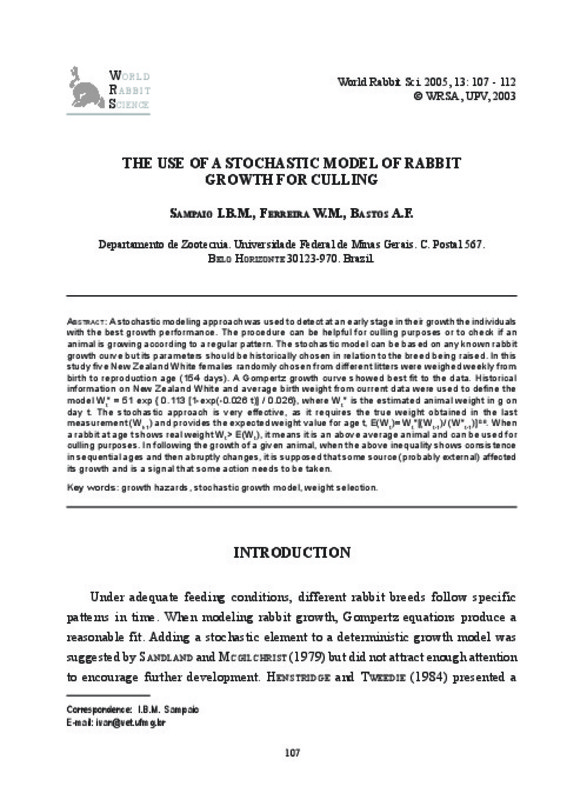JavaScript is disabled for your browser. Some features of this site may not work without it.
Buscar en RiuNet
Listar
Mi cuenta
Estadísticas
Ayuda RiuNet
Admin. UPV
The use of a stochastic model of rabbit growth for culling
Mostrar el registro sencillo del ítem
Ficheros en el ítem
| dc.contributor.author | Sampaio, I.B.M.
|
|
| dc.contributor.author | Ferreira, W.M.
|
|
| dc.contributor.author | Bastos, A.F.
|
|
| dc.date.accessioned | 2011-02-11T14:02:04Z | |
| dc.date.available | 2011-02-11T14:02:04Z | |
| dc.date.issued | 2005 | |
| dc.identifier.issn | 1257-5011 | |
| dc.identifier.uri | http://hdl.handle.net/10251/9740 | |
| dc.description.abstract | [EN] A stochastic modeling approach was used to detect at an early stage in their growth the individuals with the best growth performance. The procedure can be helpful for culling purposes or to check if an animal is growing according to a regular pattern. The stochastic model can be based on any known rabbit growth curve but its parameters should be historically chosen in relation to the breed being raised. In this study five New Zealand White females randomly chosen from different litters were weighed weekly from birth to reproduction age (154 days). A Gompertz growth curve showed best fit to the data. Historical information on New Zealand White and average birth weight from current data were used to define the model Wt* = 51 exp { 0.113 [1-exp(-0.026 t)] / 0.026}, where Wt* is the estimated animal weight in g on day t. The stochastic approach is very effective, as it requires the true weight obtained in the last measurement (Wt-1) and provides the expected weight value for age t, E(Wt)= Wt*[(Wt-1)/ (W*t-1)]0.8. When a rabbit at age t shows real weight Wt > E(Wt), it means it is an above average animal and can be used for culling purposes. In following the growth of a given animal, when the above inequality shows consistence in sequential ages and then abruptly changes, it is supposed that some source (probably external) affected its growth and is a signal that some action needs to be taken. | es_ES |
| dc.description.sponsorship | Research supported by Brazilian Research Bureau (CNPq) | |
| dc.language | Inglés | es_ES |
| dc.publisher | World Rabbit Science. ICTA. UPV | es_ES |
| dc.relation.ispartof | World Rabbit Science | |
| dc.rights | Reserva de todos los derechos | es_ES |
| dc.subject | Growth hazards | es_ES |
| dc.subject | Stochastic growth model | es_ES |
| dc.subject | Weight selection | es_ES |
| dc.title | The use of a stochastic model of rabbit growth for culling | es_ES |
| dc.type | Artículo | es_ES |
| dc.date.updated | 2011-02-11T13:47:50Z | |
| dc.identifier.doi | 10.4995/wrs.2005.525 | es_ES |
| dc.rights.accessRights | Abierto | es_ES |
| dc.description.bibliographicCitation | Sampaio, I.; Ferreira, W.; Bastos, A. (2005). The use of a stochastic model of rabbit growth for culling. World Rabbit Science. 14(2). https://doi.org/10.4995/wrs.2005.525 | es_ES |
| dc.description.accrualMethod | SWORD | es_ES |
| dc.relation.publisherversion | https://doi.org/10.4995/wrs.2005.525 | es_ES |
| dc.description.volume | 14 | |
| dc.description.issue | 2 | |
| dc.identifier.eissn | 1989-8886 | es_ES |
| dc.contributor.funder | Conselho Nacional de Desenvolvimento Científico e Tecnológico, Brasil |








